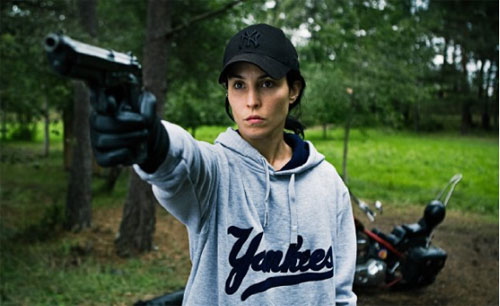Review: The Girl Who Played with Fire

A few years ago, few people would have taken the phrase "Swedish crime thriller" seriously. Sweden has long been known for films as reserved as its culture; its cinematic output has consisted mostly of thoughtful, understated, often lethargic and slightly dreary films, few of which have generated much international interest. (There are obvious exceptions, of course. Masterpieces like The Seventh Seal vaulted Ingmar Bergman into the world's top echelon of filmmakers, and the indie vampire darling Let the Right One In was a not-so-surprising success in the Twilight-crazed U.S. and Europe.)
Sweden's cinematic reputation may change, however, with a trio of films based on Stieg Larsson's smashingly successful trilogy of crime novels, all international bestsellers. The first film, the taut and gripping The Girl with the Dragon Tattoo, has wowed critics and audiences alike in dozens of countries and has just been released on DVD in the U.S. -- read Jette's review for more details.
The series' second installment, The Girl Who Played with Fire (Swedish title: Flickan som lekte med elden), opens in Austin on Friday. The Girl with the Dragon Tattoo is a very tough act to follow, but The Girl Who Played with Fire is a smart, complex and chilling thriller that rivals its predecessor in most respects.
The first film's odd-couple team of computer hacker Lisbeth Salander (Noomi Rapace) and journalist Mikael Blomkvist (Michael Nyqvist) are back for another tale of murder and mayhem, this time involving a sex-trafficking ring. A young journalist approaches Blomkvist with a potential story based on his girlfriend's thesis about sex trafficking in Sweden. Blomkvist decides to investigate the ring and its high-level clients, among them prominent businessmen and government officials who abuse young girls. He finds himself in danger soon enough, as the targets of his investigation try to stop him from publishing the story.
Meanwhile, Salander is accused of three murders related to Blomkvist's investigation and goes on the run. While pursuing his investigation and watching his own back, Blomkvist must also find Salander and clear her name.
The Girl Who Played with Fire is largely about Salander, fleshing out the character with flashbacks to her horrendous childhood and surprising revelations about her background. The story makes sense standing alone, but it also adds interesting depth to the first film, explaining Salander's motivations in far greater detail. In this respect, The Girl Who Played with Fire is essentially a chase film with an unusual twist: While Salander is running from the authorities and criminals, she's also running from her own harrowing past.
Rapace again is thoroughly captivating as Salander, perfectly portraying a brilliant mind and damaged soul -- this time around, a seemingly more mature and wearier soul. Salander regards much of the world with a cool indifference that barely hides her inner torment, and Rapace imbues her with enough intensity, intelligence and kick-ass strength to make us believe she can rise above complete dysfunction. And Rapace's sculpted, slightly hard-edged looks are well suited to Salander's dark, tattooed goth/punk persona; her sexiness is undeniable, but mostly unapproachable.
The other performances are competent if not spectacular, as most of the characters are relatively underwritten compared to the incandescent Salander. The best of the lot is Nyqvist's believably harried Blomkvist, a dedicated journalist and loyal friend whose pursuit of the truth may have dire consequences. As things get complicated, Nyqvist takes the character from a slow burn to furious desperation.
As in many thrillers, the motley crew of villains in The Girl Who Played with Fire is sometimes more interesting than the heroes. Georgi Staykov is snarlingly sociopathic as the elusive underworld figure Alexander Zalachenko. And Mikael Spreitz is amusingly menacing as Ronald Niedermann, a hulking white-haired giant who cannot feel pain and is reminiscent of a classic James Bond villain's henchman.
(Note to producers of future Swedish thrillers: It's just a small detail, but menacing bad guys like Niedermann seem far less menacing when driving white Volvo station wagons. Behind the wheel of the Volvo, the ferocious Niedermann looks like a soccer dad. A large, black Mercedes would be a far better choice; no one will think the villain is on his way to Chuck E. Cheese.)
The Girl Who Played with Fire is a stylish film with the sort of nuance and deftly edited action that are the stuff of great thrillers. There are a few glaringly unbelievable moments during the film's climax that threaten to torpedo an otherwise plausible story, but the film is so entertaining that I can forgive a few departures into clichéd action-film silliness. The film is a fine follow-up to the esteemed The Girl with the Dragon Tattoo that no doubt will satisfy Larsson's legions of fans.

